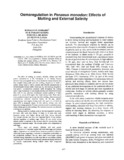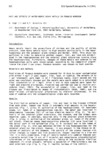| dc.contributor.author | Reyes, E.P. | |
| dc.contributor.editor | Taki, Yasuhiko | |
| dc.contributor.editor | Primavera, Jurgenne H. | |
| dc.contributor.editor | Llobrera, Jose A. | |
| dc.date.accessioned | 2012-04-20T03:41:14Z | |
| dc.date.available | 2012-04-20T03:41:14Z | |
| dc.date.issued | 1985 | |
| dc.identifier.citation | Reyes, E. P. (1985). Effect of temperature and salinity on the hatching of eggs and larval development of sugpo, Penaeus monodon. (Abstract only). In Taki Y., Primavera J.H. and Llobrera J.A. (Eds.). Proceedings of the First International Conference on the Culture of Penaeid Prawns/Shrimps, 4-7 December 1984, Iloilo City, Philippines (pp. 177-178). Iloilo City, Philippines: Aquaculture Department, Southeast Asian Fisheries Development Center. | en |
| dc.identifier.isbn | 9718511008 | |
| dc.identifier.uri | http://hdl.handle.net/10862/928 | |
| dc.description | Abstract only. | en |
| dc.description.abstract | Incubation of Penaeus monodon eggs and rearing of different larval stages were undertaken at nine temperature-salinity combinations. The eggs, nauplii, zoea and mysis from one spawner kept as stock culture at ambient temperatures of 26-30°C and salinity of 32-33 ppt were exposed to temperature levels of 23, 28 and 33°C and salinity levels of 23, 28 and 33 ppt.
Eggs and nauplii survived the sudden change of temperature and salinity (from ambient to experimental) but the zoea and mysis did not. However, salinities of 23 and 28 ppt in combination with any of the temperature levels produced weak larvae. Highest mean hatching rate was obtained at the temperature-salinity combination of 23°C-33 ppt, followed by 28°C-33 ppt and 33°C-33 ppt. Incubation periods for these treatments were 22, 16 and 14 hr, respectively. Survival rate of nauplius (taken from stock cultures) to first zoeal stage was highest at 28°C-33 ppt, followed by 33°C-33 ppt and 23°C-33 ppt with molting time of 50, 45 and 75 hr, respectively.
The nauplii exposed to 33°C-33 ppt molted to zoea stage within 38 to 40 hr but later died. Those exposed to 23°C-33 ppt and 28°C-33 ppt reached zoea stage within 57 to 60 hr and 48 to 50 hr, respectively. Similarly, the nauplii taken from the stock cultures and reared until postlarval stage (P1) under experimental conditions completed the zoea and mysis stages in 9 to 11 days at 28°C C-33 ppt, 7 to 9 days at 33°C-33 ppt, and 13 to 15 days at 23°C-33 ppt.
Statistical analysis showed that salinity had highly significant effect on rates of hatching of eggs and survival from nauplius to first zoeal stage but not temperature although the latter had an apparent effect. However, both factors affected time of hatching of eggs and time of molting from nauplius to zoea. Interaction effect was significant only on rate and time of hatching. Different sources (spawners) of eggs and nauplii did not have significant effect on time of hatching and molting from nauplius to zoea, but significantly affected the hatching rate of eggs and survival rate of nauplii to zoea stage. | en |
| dc.language.iso | en | en |
| dc.publisher | Aquaculture Department, Southeast Asian Fisheries Development Center | en |
| dc.subject | Penaeus monodon | en |
| dc.title | Effect of temperature and salinity on the hatching of eggs and larval development of sugpo, Penaeus monodon | en |
| dc.type | Conference poster | en |
| dc.citation.spage | 177 | |
| dc.citation.epage | 178 | |
| dc.subject.asfa | hatching | en |
| dc.subject.asfa | larval stage | en |
| dc.subject.asfa | salinity effects | en |
| dc.subject.asfa | shrimp culture | en |
| dc.subject.asfa | survival | en |
| dc.subject.asfa | environmental factors | en |
| dc.subject.asfa | temperature effects | en |
| dc.citation.conferenceTitle | Proceedings of the First International Conference on the Culture of Penaeid Prawns/Shrimps, 4-7 December 1984, Iloilo City, Philippines | en |
| dc.subject.scientificName | Penaeus monodon | en |



